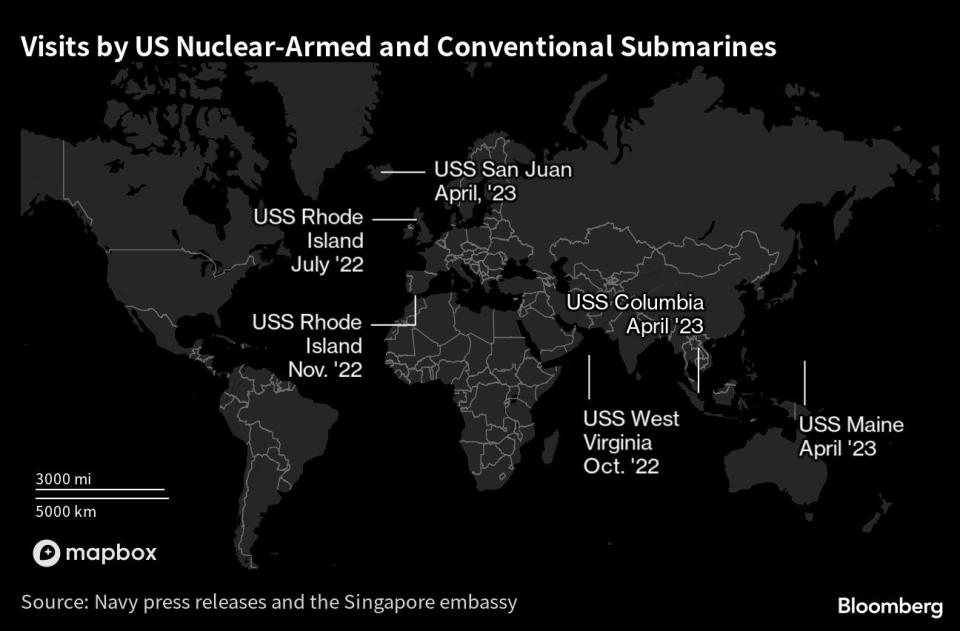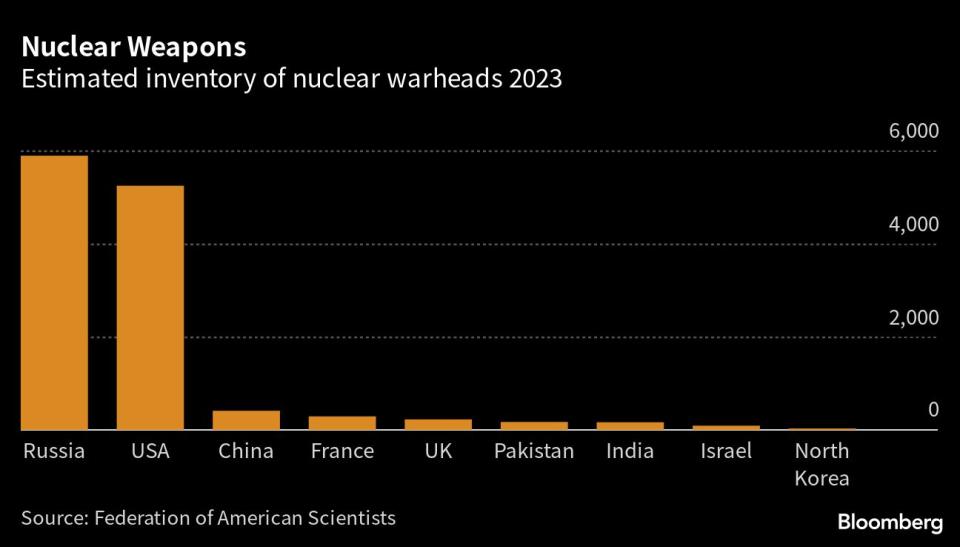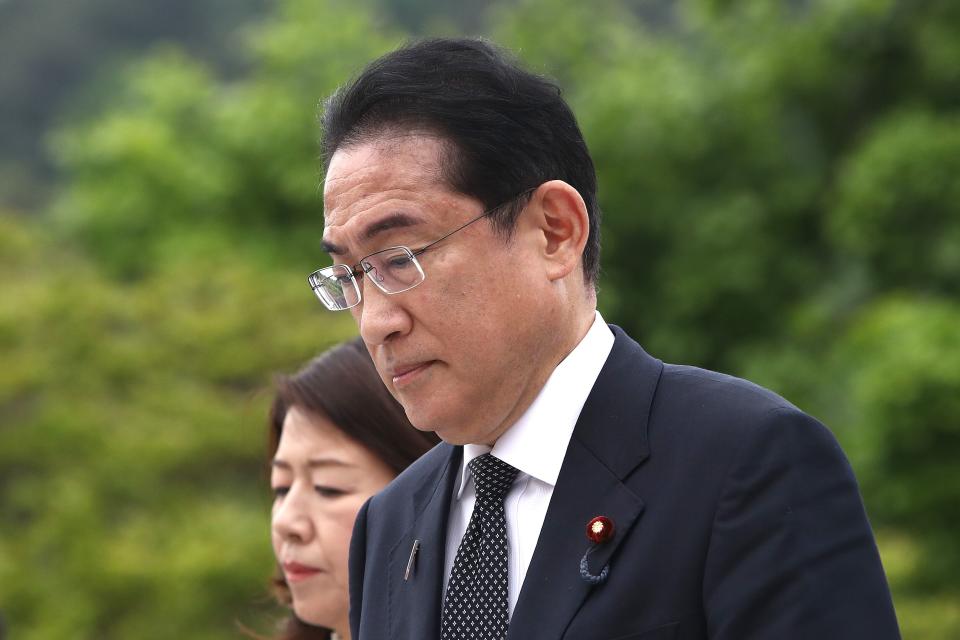Japan’s Dream of Nuclear-Free World Crashes Into Reality at Hiroshima G-7
- Oops!Something went wrong.Please try again later.
- Oops!Something went wrong.Please try again later.
(Bloomberg) -- Japanese Prime Minister Fumio Kishida brought the Group of Seven summit to his hometown of Hiroshima to persuade world leaders to scrap nuclear arms. Instead, the US allies are expected to discuss bringing more to the region to deter common foes.
Most Read from Bloomberg
Singapore Air Hands Staff Eight Months’ Salary Bonus After Record Results
Here’s How Much Wealth You Need to Join the Richest 1% Globally
Mercedes Sets Out to Make Sexy Vans With Yacht-Like Interiors
At the meeting starting on Friday, Kishida’s long-held ambition of “a world without nuclear arms” is set to clash with the harsh realities of the security challenges posed by China, North Korea and Russia, all of which neighbor Japan and possess about half of the world’s nuclear warheads.
Dealing with President Vladimir Putin, who threatened to unleash the first atomic attack on European soil as part of his war on Ukraine, will be particularly high on the agenda.
The contrast will be even sharper when leaders from the world’s wealthiest democracies on Friday visit the peace park that was ground zero for the first nuclear attack 78 years ago, which killed an estimated 140,000 people. They may also come face to face with people like Yoshiko Kajimoto, now 92, who was a girl in Hiroshima when the US dropped an atomic bomb on the city in 1945. She thought she was going to perish in a white flash.
“In this summit, I want everyone to become serious and find a way toward nuclear abolition,” she said in an interview. “I don’t want it to be settled with just some sort of a consideration or saying vague words.”
Behind closed doors, however, leaders are set to discuss ways to expand the US’s nuclear umbrella of protection offered to allies such as Japan and South Korea, which don’t have atomic weapons of their own. Previous contingency planning has weighed toward preemptive and retaliatory strikes.
“Russia’s nuclear threats combined with the rapid build-up of capabilities by North Korea and China have certainly raised the salience of nuclear weapons in Northeast Asia,” said Ankit Panda, a senior fellow in the nuclear policy program at the Carnegie Endowment for International Peace.
“Increasingly, decision-makers in these states are concerned about possible nuclear coercion in future crises and have thus doubled down on their own independent defense capabilities alongside their respective alliances with the United States,” he said.
In addition to Putin’s threats, China’s growing stockpile of warheads and missiles to send them around the world drew the attention of G-7 foreign ministers when they met last month. The US Department of Defense said in a report last year that Beijing’s nuclear warhead supply has surpassed 400 and is on a path for about 1,500 warheads by 2035.
North Korea has also been testing at a blistering pace nuclear-capable missiles designed to hit the US mainland as well as Japan and South Korea, which host the bulk of American military personnel in the region. G-7 statements have also typically highlighted other concerns regarding non-proliferation, including Iran’s atomic ambitions. The group’s leaders have been trying to get the Kremlin to implement the New START treaty on limiting nuclear weapons stockpiles.
G-7 leaders are likely to try to thread the needle between Kishida’s call for nuclear disarmament and the need to counter the growing nuclear threats around the globe, according to Nobumasa Akiyama, dean of the School of International and Public Policy at Hitotsubashi University outside of Tokyo. This will likely include a message directed at countries such as Russia and China that “nuclear weapon shouldn’t be used in any circumstances,” he added.
To cope with the crisis, there are two measures. “One is to strengthen deterrence,” he said, adding, “at the same time, we have to do some efforts to reduce the risk,” which could include talks with potential adversaries.
Over the past year, the US has brought more assets capable of launching nuclear strikes closer to Japan and South Korea. This has included the first visit by a US carrier group in five years to waters off the Korean Peninsula, which was followed by three more visits, as well as joint training among the US, Japan and South Korea for intercepting missiles and hunting submarines.
More shows of force are on the way. South Korean President Yoon Suk Yeol won assurances during a summit with President Joe Biden in April to strengthen extended deterrence measures, including more regular deployments of nuclear-armed submarines.
One such submarine is set to make a publicly announced visit to South Korea within months, the first such trip in decades, according to Pentagon officials. The Ohio-class submarines, nicknamed Boomers, each carries up to 20 D-5 Trident ballistic missiles and are designed to glide undetected. Their port calls have seldom been disclosed — much less trumpeted — by their commanders for security concerns.
The displays of US military might are meant to serve as a reminder of a warning Biden issued to leader Kim Jong Un that a nuclear strike by North Korea would be suicidal. Kim, however, will likely use the moves to justify tests of new weapons and avoid resuming stalled disarmament talks with the US.
“Closer US-South Korea-Japan military cooperation will likely reinforce Pyongyang’s current foreign policy of alignment with China and Russia, which in turn will have negative consequences for the prospects of US-North Korea diplomatic relations,” said Rachel Minyoung Lee, a regional issues manager at the Vienna-based Open Nuclear Network who worked as an analyst for the CIA’s Open Source Enterprise for almost two decades.
While the US has removed its deployments of nuclear weapons from Japan and South Korea decades ago, it maintains what the Pentagon bills as America’s largest munitions depot in the world in Guam. The jungle-strewn island is home to a US Air Force base with bombers capable of delivering nuclear strikes in places such as North Korea and further afield.
That has also made the island a target. As China and North Korea rolled out new missiles that could hit the US territory, the Biden administration began installing a $1.5 billion missile defense system on Guam, John Plumb, the assistant secretary of Defense for Space Policy, told a US Senate committee this month.
All of that doesn’t bode well for residents of Hiroshima who want G-7 leaders to commit to getting rid of nuclear weapons once and for all.
“Shouldn’t we create a world where we don’t rely on nuclear weapons?” Kazumi Matsui, the city’s mayor, said in an interview from his offices. “Now is the time to consider how we can truly achieve that.”
--With assistance from Alberto Nardelli.
Most Read from Bloomberg Businessweek
Sweetgreen Tests Robots to Make Faster, More Efficient Sad Desk Salads
Recession Calls Keep Getting Pushed Back, Giving Soft Landing Believers Hope
©2023 Bloomberg L.P.





